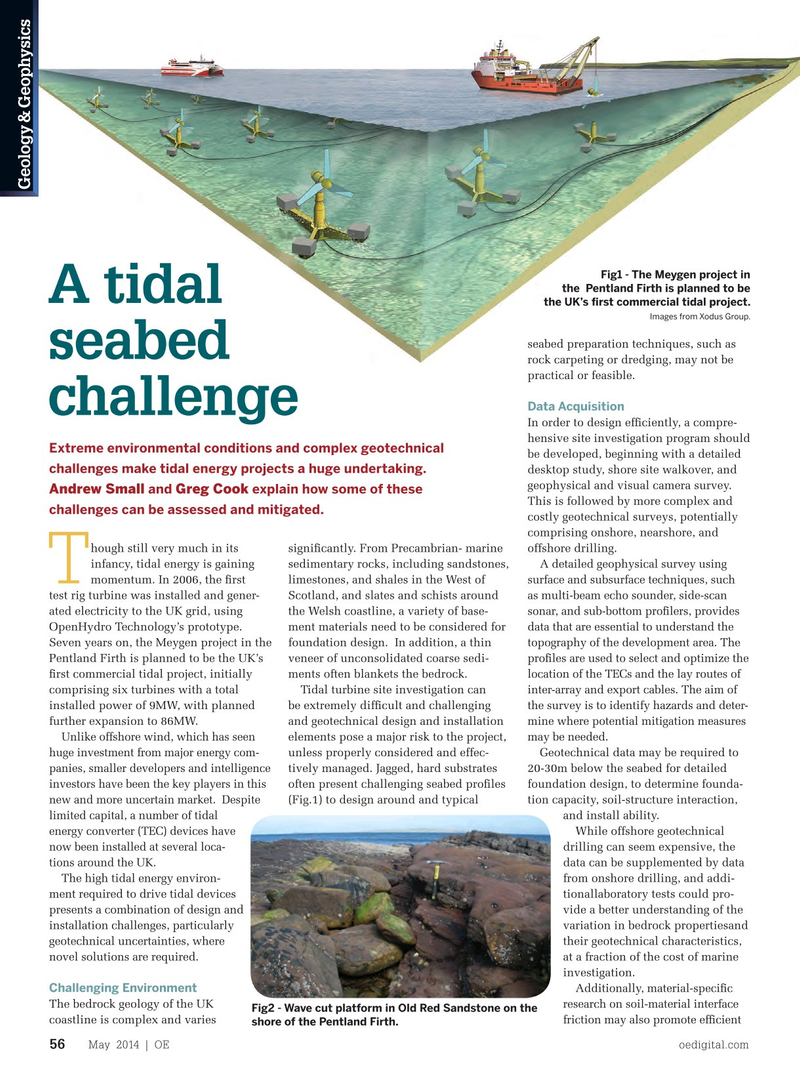
Page 54: of Offshore Engineer Magazine (May/Jun 2014)
Read this page in Pdf, Flash or Html5 edition of May/Jun 2014 Offshore Engineer Magazine
Geology & Geophysics Fig1 - The Meygen project in the Pentland Firth is planned to be
A tidal the UK’s frst commercial tidal project. Images from Xodus Group.
seabed preparation techniques, such as seabed rock carpeting or dredging, may not be practical or feasible.
Data Acquisition challenge
In order to design effciently, a compre- hensive site investigation program should
Extreme environmental conditions and complex geotechnical be developed, beginning with a detailed challenges make tidal energy projects a huge undertaking. desktop study, shore site walkover, and geophysical and visual camera survey.
Andrew Small Greg Cook and explain how some of these
This is followed by more complex and challenges can be assessed and mitigated. costly geotechnical surveys, potentially comprising onshore, nearshore, and hough still very much in its signifcantly. From Precambrian- marine offshore drilling.
A detailed geophysical survey using infancy, tidal energy is gaining sedimentary rocks, including sandstones,
T surface and subsurface techniques, such momentum. In 2006, the frst limestones, and shales in the West of as multi-beam echo sounder, side-scan test rig turbine was installed and gener- Scotland, and slates and schists around sonar, and sub-bottom proflers, provides ated electricity to the UK grid, using the Welsh coastline, a variety of base- data that are essential to understand the
OpenHydro Technology’s prototype. ment materials need to be considered for topography of the development area. The
Seven years on, the Meygen project in the foundation design. In addition, a thin profles are used to select and optimize the
Pentland Firth is planned to be the UK’s veneer of unconsolidated coarse sedi- location of the TECs and the lay routes of frst commercial tidal project, initially ments often blankets the bedrock.
inter-array and export cables. The aim of comprising six turbines with a total Tidal turbine site investigation can the survey is to identify hazards and deter- installed power of 9MW, with planned be extremely diffcult and challenging mine where potential mitigation measures further expansion to 86MW. and geotechnical design and installation may be needed.
Unlike offshore wind, which has seen elements pose a major risk to the project, huge investment from major energy com- unless properly considered and effec- Geotechnical data may be required to panies, smaller developers and intelligence tively managed. Jagged, hard substrates 20-30m below the seabed for detailed investors have been the key players in this often present challenging seabed profles foundation design, to determine founda- new and more uncertain market. Despite (Fig.1) to design around and typical tion capacity, soil-structure interaction, limited capital, a number of tidal and install ability.
energy converter (TEC) devices have
While offshore geotechnical now been installed at several loca- drilling can seem expensive, the tions around the UK.
data can be supplemented by data
The high tidal energy environ- from onshore drilling, and addi- ment required to drive tidal devices tionallaboratory tests could pro- presents a combination of design and vide a better understanding of the installation challenges, particularly variation in bedrock propertiesand geotechnical uncertainties, where their geotechnical characteristics, novel solutions are required. at a fraction of the cost of marine investigation.
Challenging Environment Additionally, material-specifc
The bedrock geology of the UK research on soil-material interface
Fig2 - Wave cut platform in Old Red Sandstone on the coastline is complex and varies friction may also promote effcient shore of the Pentland Firth.
May 2014 | OE oedigital.com 56 056_OE0514_G&G3_Xodus.indd 56 4/18/14 7:47 PM

 53
53

 55
55